Archive for December, 2012
I recently discovered 100 Armenian legends published by the Ararat Brandy company on their website and would like to share some of them with you (now and then). This one is about one of most ancient Armenian cities called Moush (in today’s Turkey known as Muş).
There was a city on the Aratsani River where people used to quarrel among themselves. They were arrogant and remained enslaved by their morose vanity. Pride prevented them from forming impartial opinions, even about themselves.
All they did from dawn until dusk was argue with each other and lecture each other, finding faults with each other for no reason. When disputes flared up so much that things came close to a fight, the Armenian goddess of wisdom Nane came to people’s aid. She would send such a thick blanket of fog over the entire city that the people caught in it could not see anything around them. In the end, they were forced to stop shouting their threats and insults into white nothingness.
“You just wait!” they would cry. “As soon as the fog lifts we’ll continue our discussion!”
But the fog floated over the city like a cloud, thick and slow. The fog lasted until the irreconcilable wranglers forgot their grievances and peaceful tranquil life returned to the city. The wise Nane did that quite frequently. She would cover the city in mist as if calling people to righteousness. And eventually she succeeded! The people of the city became quiet, polite and attentive to each other. They even learned to enjoy the frequent fogs.
Because of these fogs the city became known as Mshoush* and a few centuries later it was shortened to Moush.
Awesome new music video from Sirusho with traditional Armenian flavor.
Here is a small selection of beautiful Armenian wallpapers I found. Don’t forget to push View full article button!
The Armenian epic “Daredevils of Sassoun” was today inscribed on the Representative List of the Intangible Cultural Heritage of Humanity of UNESCO. The Intergovernmental Committee for the Safeguarding of the Intangible Cultural Heritage meeting was held at UNESCO Headquarters.
Performance of the Armenian epic of ‘Daredevils of Sassoun’ or ‘David of Sassoun’
Armenia — The traditional Armenia epic Daredevils of Sassoun recounts the story of David of Sassoun, a defiant youth who defended his homeland in an unequal duel against the evil. This heroic epic is recounted and sung in sections in a lyrical voice with rhythmic enunciation. It is performed, usually sitting, to the musical accompaniment of a duduk during weddings, birthdays, christenings and major national cultural events. There are 160 variants and performances may last up to two hours.
Source: UNESCO
Beautifull song from Anush Arshakyan, performing one of classical Armenian songs by Komitas (founder of modern Armenian classical music)







